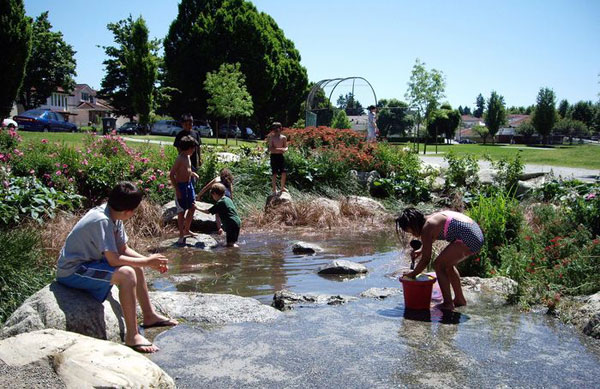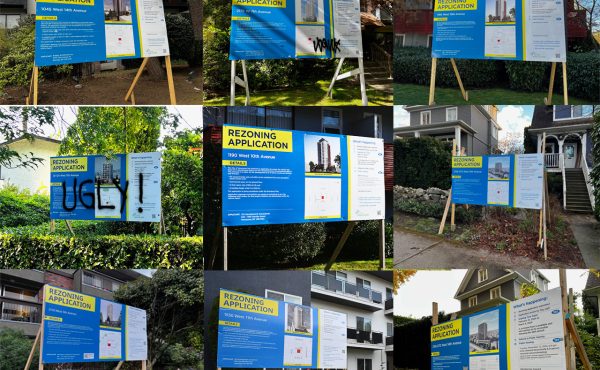

What makes a public park successful? Perhaps we can glimpse and answer this difficult question through looking closely at Norquay Park – one of the few Vancouver parks, along with McAuley Park and Robson Park near Fraser St., abutting the heavily trafficked Kingsway and bordered by Wales Street and Rhodes Street. This parks presents a unique local case where a once neglected piece of green has become a beacon of community engagement and resident-driven design.
On July 20, 2011, the transformed park was officially opened with speeches by Lynne Yelich, Minister of Statefor Western Economic Diversification, Vancouver Deputy Mayor Heather Deal, and Park Board Chair Aaron Jasper. Cake and blue-grass music accompanied a diverse group of neighbourhood residents while government officials championed the success of the park. Children played near the new clubhouse, pop and hot dogs were sold and seniors gathered together with a common understanding that Norquay Park has become a community node instead of a passive green space with little to offer. Its success has brought residents travel from as far as Burnaby to use the park following the revitalization.
Approximately 2.23 hectares (5.5 acres) in size, the redesigned Norquay park features some extremely innovative designs around rainwater capture and reuse. The children’s spray pad doubles as a groundwater capture system that sends excess runoff into a nearby rain garden which then provides water for the parks landscaping.
Although this system may appear straight-forward – common sense, even – it differs greatly from the standard single-use water systems favoured by codes throughout North America. As a result, the implementation of this seemingly simple infrastructure developed out of a intense discussions around issues such as code compliance – issues that are not for the faint of heart to question. In fact, the Norquay system was a step down from what was originally envisioned for the park which was full on-site water management. Despite this shortcoming, Norquay’s water management strategy marks a pivotal and significant step forward in how the City tackle water infrastructure and is certainly an important precedent towards making on-site water management the norm in Vancouver.
Technicalities aside, perhaps the greatest impact of how the water at Norquay Park is treated is that it has a direct impact on how people – children, in particular – engage natural elements. Those who have the pleasure of visiting the park are sure to see throngs of kids playing within and wadding around the small rain garden among the rocks, tall grasses, and plants. What a difference from the traditional water parks peppered across the city. To my knowledge, this is the first park in the city that not only allows, but encourages, such intimate contact with a “wilder” landscape. This unique feature makes the park a great destination for families with children looking to beat the summer heat.

Adding to the flare and flavour of Norquay are flattering mosaic tile installations throughout the park (see above picture) installed by commissioned artists from the immediate area created to reflect the distinct character and spirit of the community. Park design concepts were developed and displayed by the landscape architecture firm Durante Kreuk Limited which passed both board approvals for design and construction.
So, returning to the original question then: what makes a public park successful?
According to Steve Wong, Project Manager of the Vancouver Board of Parks and Recreation, the answer is clear; “all the elements are put together,” which Wong further clarifies as the result of a “comprehensive community engagement process from early on.”
The park includes fantastic and diverse uses such as a ball hockey court, festival space (amphitheatre-type design of the basketball court), a Tai-Chi space, clubhouse, picnic benches, grassy knolls for lounging, a modern and extensive playground and of course, the children’s spray pad with its meandering “river” and rain garden. These amenities are all packed into a section that is roughly half the size of the park. The remaining portion is comprised of an open sports field large enough for soccer games, field hockey or football to name a few.
The park’s success therefore lies within its capacity as a local and regional draw, but also as a hub for a diversity of users. Community members were consulted from start to finish, including involvement in redesign. They were also active in creating a cohesive identity for the park while maintaining a project scope that fit within the city’s budgetary constraints.
However, not even the most successful of projects goes without its setbacks and battles. At the opening event, there was a small, but vocal group representing a community-based network called ‘Eye on Norquay‘ which stands against the city’s proposal for development along the Kingsway corridor. One specific property that recently received approval from the city for height and density rezonings is 2699 Kingsway.
These vocal residents were front and centre on July 20th holding placards calling on city planners to reconsider the redevelopment proposals along Kingsway and to stop using the park as an attractive distraction to the issues at stake; namely community opposition to proposed developments along the Kingsway.
Conflict aside, the general mood surrounding Norquay Park is jovial, upbeat and engaging – as anyone who has witnessed the hordes of people using the facilities will readily admit to. Most residents are excited about the revitalization and have been for months before the official opening.
Given the success of the Norquay Park at all levels, one can only hope that this type of development will become the standard for public parks across the city – one that respects the natural environment and community identity, and ultimately encourages those from beyond the borders of the neighbourhood to come and partake in the interaction between the two.
***





2 comments
This city likes to state that Norquay park is special being the only park in Vancouver along Kingsway. In doing so it ignores McAuley Park (not much of a park, sure), but also ignores Robson Park just west of Fraser which is a pretty significate oversight.
Hi Joe,
Thanks for the great comment…..you’re completely right. Both Robson and McAuley Park are significant oversights. Kingsway is one of those car-oriented streets that isn’t kind to public spaces beside it.
Anyhow, we’ve corrected the content to reflect this.
Thanks again,
E